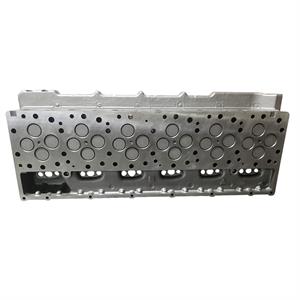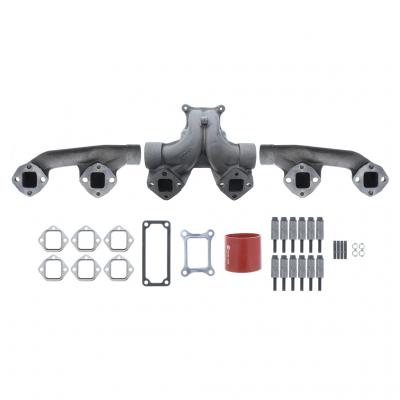The Anatomy of a Diesel Engine: How Diesel Engines Work

A diesel engine is one of the world's most sophisticated machinery developed by Rudolf Diesel. Diesel engines have many parts that consist of dozens of parts. Whether you’re new to the world of diesel mechanics or you’re a diesel engine user interested in learning more about how the machinery works, you’ve come to the right place.
In today’s blog post, the team of professionals at Heavy Duty Pros is going to go over the various parts of a diesel engine, what makes a diesel engine different from a gas engine (aside from the obvious, of course), and how the various parts of this machinery work to keep your vehicles running. Let’s jump in.
A Look At The Various Parts of A Diesel Engine
A diesel engine is a reciprocating piston engine that uses air and fuel to combust and create power. Within the engine, several parts interact and share energy to move pistons and elements involved in the combustion process. You'll find the various parts of a diesel engine rebuild kits here at Heavy Duty Pros or from other reputable sources, but let’s dive further into these different parts and their functions.
Cylinder Block
The cylinder block is the central core of a diesel engine. It's where pistons are located and connect to the crankshaft. The cylinder or engine block is also composed of many parts that work together to provide power to the vehicle. Most often made from cast iron or aluminum, the cylinder block is durable enough to smoothly maintain the power that the 2-stroke or 4-stroke engine requires.
Within the cylinder block, there are several components that one should also be aware of, these are the cylinder liner, water jacket, and oil feed lines.
Cylinder Liner: The cylinder liner is installed inside the cylinder block and goes up and down the cylinder block. This piece of the engine helps to provide a smooth surface for the motion of the piston.
Water Jacket: Water jackets are water-filled casings that help with the cooling process. These are located inside the cylinder block and placed strategically around the liner where the pistons will be moving.
Oil Feed Lines: This is a hole on the cylinder block that is going to transfer oil from the cylinder head to the crankcase. This feature helps with the oil circulation process needed for all diesel engine parts.

Piston and Connecting Rod
The piston is one of the primary players when looking at diesel engines. The function of the piston is to adjust the volume within the cylinder. When the piston goes down, the volume of the cylinder goes up and when the piston goes up, the volume of the cylinder goes down. The connecting rod is what continues the movement of the piston to the flywheel.
Within each piston, there are three additional core parts that are attached: compression rings, the oil ring, and piston pins.
Compression Ring: The purpose of these rings is to maintain compression during the compression stroke of the cycle. This ring goes between the piston wall and the liner.
Oil Ring: The oil ring goes below the compression ring. The purpose of this ring is to prevent engine oil from making its way into the compression chamber.
Piston Pin: The piston pin is the piece that connects the piston to the connecting rod. This tubular pin works as a hinge to help with the functionality of the piston and rod.
Crankshaft
This mechanical piece of the diesel engine serves to transform the linear motion of the pistons into a rotation motion. Connected by the rod, the rotation of the crankshaft is what leads to the movement of the pistons in the cylinders. This movement then delivers motion to the crankshaft, transferring to the flywheel, and then moving the vehicle. These pieces are often made from durable steel and intended to handle the wear and resistance of this motion. There are various parts that are attached to the crankshaft including the crank pin, crank journal, crank journaling, and weight balance.
Crank Journal/Pin: Crankshaft journals both ride in the main bearing saddles of the cylinder block as well as connect to the big ends of the connecting rods. These journals ride in both the main bearings and rod bearings.
Counterweight: The weights are placed on opposite sides of the crankshaft. The counterweights are designed to provide offset balance to the crankshaft while the engine is running and the piston and connecting rods are in motion.
Fuel Injectors
The fuel injectors within a diesel engine are the part that will release the fuel into the combustion chamber. Diesel engines differ from gasoline engines in that the fuel injected is not a mixture of fuel and air. Rather, the fuel injectors of a diesel engine will release a mist of fuel into the combustion chamber through small, precise holes. This piece provides the fuel needed to ignite the vehicle.
Oil Pan
The oil pan within the diesel engine has a pretty straightforward purpose: it holds the oil. In a diesel engine, the oil pan can be found at the bottom of the crankcase. While the purpose is straightforward, this part of the diesel engine does play a major role. All oil in the oil pan is used to keep the various parts of the engine lubricated, which is important given the amount of movement within a diesel engine.
Head Gasket
The head gasket lies between the engine block and the cylinder head. The primary role of the head gasket is to keep any liquids from making their way into the cylinder heads.
Flywheel
The flywheel can be found at the end of the crankshaft. This part does quite a bit when looking at the functionality of a diesel engine. For starters, the flywheel is used to minimize noise as the crankshaft rotates. It does this by minimizing vibrations from the crankshaft as well.
Exhaust System
The exhaust system is the final part of the diesel engine that we’re going to discuss. The exhaust system is crucial given that it is what releases the built-up fuel from the engine. When it comes to working on diesel engines, exhaust systems tend to be one of the aftermarket pieces that drivers will invest in. Aside from adding a bit of flair to the vehicle, a higher quality or larger exhaust system can be beneficial for the functionality of the engine and for how hard your engine needs to work. All in all, the exhaust system of your diesel engine can contribute to engine life and overall fuel economy.

How a Diesel Engine Works
With a better idea of the various moving parts that a diesel engine is made up of, it’s time to gain a better understanding of how they work together to power so many different vehicles. From everyday trucks to larger pieces of equipment and machinery, the diesel engine is powerful and functions very differently from a standard gas-run engine. That being said, a 4-stroke diesel engine performs similarly to a gasoline engine in that it requires a 4-stroke cycle. The four strokes of the engine are intake, compression, power, and exhaust.
The diesel engine process starts with clean air entering the cylinders of the engine. This is unlike a gas engine where a fuel-and-air mixture is used to trigger the cycle. With the air in the cylinder, the motion of the piston compresses the air, causing the air to heat up to an extremely high temperature.
Once the piston has gotten close to the top of the cylinder, fuel is injected under high pressure through very small, precise holes in the fuel injector. This design causes the fuel to enter the engine in the form of a stay. Once in the engine, the fuel vaporizes. This combination leads to the ignition without the need for a spark, which pushes the piston down to then start the engine and power the vehicle.
Once the piston is close to its lowest position, the built-up exhaust needs to be released. This is done by having the exhaust valve open up to release the spent fumes from the combustion chamber. After the built-up exhaust has been released, the cycle begins again.
Benefits of Diesel Engine
Given the difference in functionality with diesel engines, it should come as no surprise that there are benefits associated with the functionality and mechanics of this engine system. Below are just a few of the reasons a diesel engine might be used over a gasoline-run engine.
More Energy Extracted
The cycles of a diesel engine allow for more energy to be extracted, which is one of the many reasons that diesel engines are used in vehicles that are more likely to travel long distances. In these instances, think of vehicles along the lines of semi trucks, locomotives, and the like.
Higher Mileage Options
Because of the amount of energy that diesel engines are able to extract, they truly are a good fit for any vehicle that is looking for a higher mileage option. As we just mentioned, vehicles like semi trucks or locomotives are going to benefit more from an engine that naturally emits more energy, allowing them to sustainably travel further distances.
Cost Effective
Another reason that so diesel engines are so popular is that they are more cost-effective than the alternative gas engine. Again, we need to think about the cost of running some of those larger vehicles that will be traveling long distances. With an engine that can run efficiently for long distances, the cost of fueling that vehicle drops.
Large, long-distance vehicles aren’t the only vehicles that benefit from a lower cost in fuel. Many truck owners will also opt for a diesel engine because it is a more affordable fuel option. While trucks may not have the same fuel tank as a semi, they do have some pretty large fuel tanks. Being able to save any money while filling up fuel is a bonus.
Shop Diesel Engine Parts & Rebuild Kits at Heavy Duty Pros
It all comes down to this: correctly understanding how your diesel engine works can keep you and your machine(s) happy.
At Heavy Duty Pros, we’re one of the few businesses specializing in diesel engine parts and rebuild kits for sale across the US. We stock a wide range of parts for all makes and models of diesel engines, including fuel filters, cylinder heads, and air cleaners . If you need help maintaining your diesel engine in good working order, shop our online catalog today.